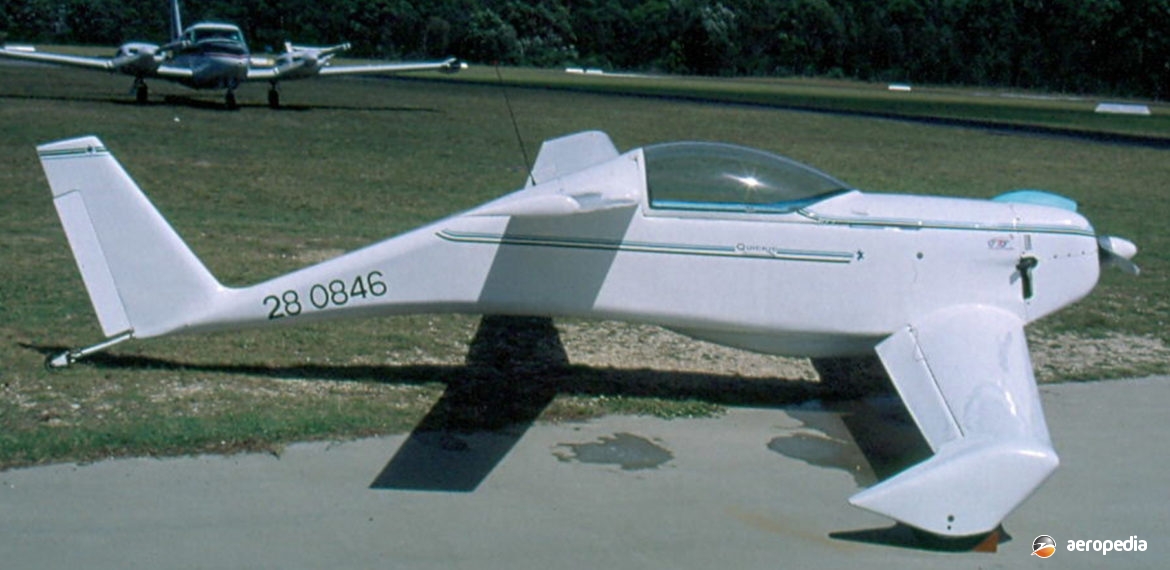Photograph:
Quickie Q-1 28-0846 (c/n N109) at Moruya, NSW in 2002 (David C Eyre)
Country of origin:
United States of America
Description:
Single-seat light sport aircraft
Power Plant:
One 13.4 kw (18 hp) two-cylinder four-stroke converted Onan industrial engine
Specifications:
- Wingspan: 5.08 m (16 ft 8 in)
- Canard span: 4.67 m (15 ft 4 in)
- Length: 5.28 m (17 ft 4 in)
- Height: 1.19 m (3 ft 11 in)
- Wing area: 4.27 m² (46 sq ft)
- Max speed: 203 km/h (126 mph)
- Cruising speed: 195 km/h (121 mph)
- Stalling speed (power off): 85 km/h (53 mph)
- Rate of climb at sea level: 130 m/min (425 ft/min)
- Service ceiling: 3,749 m (12,300 ft)
- Range at normal cruising speed: 917 km (570 miles)
- Empty weight: 109 kg (240 lb)
- Loaded weight: 218 kg (480 lb)
History:
In 1975 Gene Sheehan and Tom Jewett began looking for a small, reliable engine with low fuel consumption to power a small, efficient, sporting aircraft. After much testing they decided that the 13.4 kw (18 hp) Onan industrial engine of aluminium construction was ideal for the purpose. In 1977 the men approached Burt Rutan, designer of the revolutionary Vari-Viggen, VariEze, etc, series of aircraft to design an aeroplane which would be light enough to produce the required performance with good fuel economy.
Problems were encountered in the design basically because of the low power available, and the necessity to keep overall weight to a minimum. Eventually the tractor canard/tail-less biplane configuration was used, with the pilot being seated near the centre of gravity, and the main undercarriage incorporating the canard surface. A full-span elevator/flap was fitted on the canard inboard of the ailerons on the rear wing, and the tailwheel fairing served as a rudder. Construction of a prototype began in August 1977 and, after 400 man-hours, it was flown for the first time on 15 November. Test flying soon revealed that the tailwheel fairing was not adequate and a conventional fin and rudder were added.
The name ‘Quickie’ was soon given to the aircraft because of its high cruising speed and speed of construction. The machine is built of fibreglass sandwich with low-density rigid foam forming the core material. The structure was fabricated directly over the shaped core, thus reducing construction time and providing a number of other important features.
With a 91 kg (200 lb) pilot the Quickie Q-1 could cruise for 804 km (500 miles) at 185 km/h (115 mph). Cruising at 145 km/h (90 mph) the fuel consumption was 35.75 km per litre (100 miles per gallon).
The Quickie Q-1 was developed into theQ-100, and later the Q-2 and Q-200 two seat variants (dealt with separately). The Q-2 was developed from the Q-1 by the original designers with Canadian, Garry Le Gare, in 1980, was first flown on 1 July 1980. It was usually powered by a 56 kw (75 hp) Revmaster 2100-DQ engine. Wingspan remained the same as the Q-1 but the wing area increased to 6.224 m² (66.99 sq ft) and it had a cruising speed of 252 km/h (156 mph), a range at 75% power with reserves of 1,092 km (679 miles), and a loaded weight of 499 kg (1,100 lb). Useful load was 227 kg (500 lb).
A variant of the Q-2 was the Q-200, introduced in 1982, which is powered by a 75 kw (100 hp) Continental O-200 engine and cruises at 75% power at 306 km/h (190 mph). A tricycle undercarriage variant is also available. More than 500 Q-1s and over 1,000 Q-2s and Q-200s have been sold in kit form. Eight examples of the series are registered in Australia and four in New Zealand.

